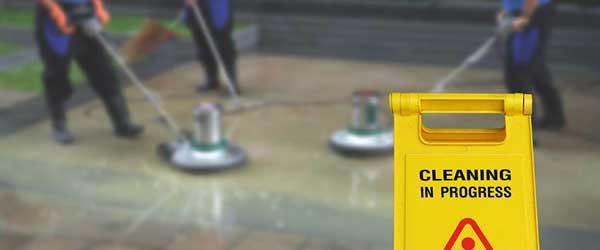Workload a job right to meet customer expectations, generate the “clean” results you’re looking for and ensure a profit.
[EasyDNNnewsToken:Left Justify Embed 300 x 250]
“Workloading” is not just an overused industry term. It serves a real purpose and, when implemented correctly, it has a profound positive impact on everyone, including the client, the front-line staff, middle management, the financial overseers and the organization as a whole. Of course, the opposite is true. If custodial workloading is not managed appropriately, the negative impact will affect everyone in your organization as well as your clients, and the outcomes will be costly both in terms of dollars and cents and your reputation.
The Eighty-five Percent
So why all the hype about this widely recognized terminology and exactly why is it so important to get it right in custodial operations? Now, more than ever, efficient and equitable workloading is key not only to managing your budget (and we all know we are expected to do more with less these days) but in providing clean and safe work environments within the proposed level of service. Remember, 85% of the custodial operations budget is labor and the rest is equipment and supplies; having that 85% working productively 100% of the time is a must. Anything less is likely to result in detrimental outcomes.
Detrimental Outcomes
What exactly are these detrimental outcomes and exactly what impact will improper workloading have on an organization relying on a clean and safe environment? Well, let’s take a look at some examples. Imagine if your organization were an Acute Healthcare Facility. We will take a look of the impact of poor workloading from the “bottom” to the “top,” so to speak. If front line cleaning staff are expected to do more with less and the tasks they are expected to perform, when performed correctly, add up to more hours than they are scheduled to work, that means that something in their job routine has to give. We know the answer; either corners will be cut or work will not be performed. Also, if work is not distributed equitably, and this can often be the case, morale of the cleaning staff is affected. So how do you think an overworked employee with poor morale will perform their daily tasks?
Now imagine cleaning tasks not being performed to their fullest extent or with the attention they deserve. We all know what can happen next. Contaminated surfaces, cross-contamination and yes – infectious diseases can spread. Spread from patient to patient, across an entire wing or ward of a hospital and yes in some cases across several wings. Now we have the front line staff impacted as well as the clients/customers who entrust their lives to the organization.
This cost of an outbreak in any institution is extremely high monetarily and in terms of public opinion and reputation as well. The impact makes its way all the way to the “top” and the CEO. If fatalities are involved in this scenario, the impact is far greater and will entail investigations, possibly lawsuits; the gravity of the impact for those who lost loved ones is not even measurable.
You could look at similar scenarios in educational facilities and find some similar impacts and outcomes as well. Other outcomes might be low student enrollment due to poor cleanliness and physical environment. If enrollment is down, revenue to the organization is down. If revenue is down, budget cuts will likely ensue, and, well, you get the picture.
New Tools for Complex Processes
So back to the “workloading” itself; now that we understand why it is so important, we need to know how to ensure we get it right.
– How do we ensure productivity?
– How do we ensure efficiency?
– How do we ensure equitable workloads amongst staff?
There are several tools on the market today (some more comprehensive than others) to assist custodial operations managers in workloading efficiently and accurately. These software tools have industry time standards for hundreds of custodial tasks, using hundreds of different pieces of equipment built into the software, so there is an accurate way to measure the amount of work performed. Associating these tasks with a job routine or employee allows the tool to determine whether workloads are divided equitably. Productivity can also be measured in the same manner. If one is looking to gain productivity, one could simply and quickly see the impact of swapping out one task for another or one piece of equipment for another.
Back in the day, Custodial Operations Managers simply relied on their “knowledge, know-how and expertise” to determine whether they had their facilities workloaded appropriately. Today, with far more complex work processes, hundreds of cleaning tools on the market, and productivity demands from clients and financial departments and in some cases industry cleaning regulations, it is much more difficult to determine fair and equitable workloading by calculating it in our heads. We are all turning to technology to make our lives easier and software tools and apps seem to fulfill our needs in many cases. So it makes sense that there is a tool available to assist custodial managers in managing their cleaning operations. You use technology in other parts of your operations, why not with staffing levels.
Buy-in From Senior Leadership
With workloading continuing to be absolutely critical to the success of custodial operations and positive outcomes in clean, healthy and safe environments, it is imperative that custodial operations managers continue to have these notable conversations about the importance of “getting it right” with their senior leadership team. They need to have a vested interest in your operations. They need to understand your business. Your success is their success. When you are presented with the dilemma of “doing more with less,” don’t just say “okay, we will have to make it happen.” Go back to your senior leadership team and provide them with two or three specific, explicit and detailed workloading scenarios along with the accompanying impact reports (which software tools will provide) and together make a decision that holds all of you accountable and one that you can all live with.
It is the age of information, and we can all agree information is power – bring your custodial operations to a new level by harnessing the power of technology!






